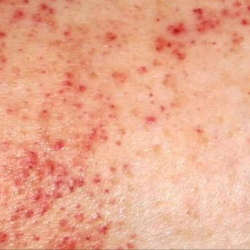Petechiae in Relation to Hepatitis C and Cancer
 Hepatitis C is a viral infection that causes inflammation in the liver. The liver plays a role in other body systems, including the skin. People with cryoglobulinemia may or may not have symptoms. When symptoms are present, they typically include a skin rash with red or purple spots (petechaie) or a purplish discoloration from bleeding under the skin (purpura).
Hepatitis C is a viral infection that causes inflammation in the liver. The liver plays a role in other body systems, including the skin. People with cryoglobulinemia may or may not have symptoms. When symptoms are present, they typically include a skin rash with red or purple spots (petechaie) or a purplish discoloration from bleeding under the skin (purpura).
Some cancers, such as leukemia, can cause thrombocytopenia, which is a deficiency of platelets in the blood. This causes bleeding into the tissues, bruising, and slow blood clotting after injury. Signs of thrombocytopenia is superficial bleeding into the skin that appears as a rash of pinpoint-sized, reddish-purple spots (petechiae), usually on the lower legs.
SPA MANAGEMENT
What is the cause of petechiae in your client?
For people with hepatitis C, they can incur a rash that is usually a symptom of cryoglobulinemia, which is a blood vessel problem that happens when proteins in blood stick together in cold weather.
Chemotherapy agents can differ in how they cause thrombocytopenia: Alkylating agents affect stem cells, Cyclophosphamide affects later megakaryocyte progenitors, Bortezomib prevents platelet release from megakaryocytes, and some treatments promote platelet apoptosis.
Determine any medications; contraindications and cautions before proceeding with any spa treatment.
Treatments that can be offered:
- Pressure modifications are absolutely necessary when performing any spa service.
- If client has petechiae over most of their body, any spa service can be contraindicated as you don’t want to exacerbate any bleeding/bruising in this client. If the client has petechiae in a localized area, a light effleurage can be done, or avoid the area to avoid further damage.
- Corrective makeup or remedial camouflage can cover and disguise this rash.
When trying to determine what petechiae looks like:
- Flat, pinpoint spots that are less than 2 millimeters in size that generally appear in clusters anywhere on the body. Spots larger than 2 millimeters caused by bleeding are called purpura.
- These spots are typically red, brown, or purple in color and can turn purple or rust colored as they fade
Estheticians: If you put pressure/press down on these red, brown, or purple clusters and they don’t turn lighter in color, they are petechiae and not a rash.
As with treating any type of skin condition, it's best to be covered by liability insurance to protect yourself against claims.
DISCLAIMER: Work within the scope of your license/certification.
 About the Author
About the Author
Mórag Currin is a highly sought-after esthetic educator with more than 27 years of spa industry experience and more than twelve years of training and training management experience. She travels around the globe with her training and expertise, helping to raise the bar in the spa industry and to open the door to all people, regardless of skin type or health condition. To learn more about this topic and many other skin challenges, diseases, and symptoms, check out Mórag’s book, Health Challenged Skin: The Estheticians’ Desk Reference.

ASCP Member Discount
ASCP Members receive 30% off Health Challenged Skin: The Estheticians’ Desk Reference. Click the link here to access your exclusive discount!
Frequently Asked Questions:
- What is petechiae? Petechiae are rashes of pinpoint-sized, reddish-purple spots found under the skin and caused by bleeding.
- What causes petechiae? Petechiae can have many causes that aren’t due to underlying disease including bug bites, abrasion and trauma to the skin, and medication side effects. Other causes include platelet disfunction, coagulation disorders of the blood, cancer, or hepatitis C.
- What does petechiae look like? Petechiae presents with flat, pinpoint spots that are less than 2 millimeters in size that generally appear in clusters anywhere on the body. Spots larger than 2 millimeters caused by bleeding are called purpura. These spots are typically red, brown, or purple in color and can turn purple or rust colored as they fade.
- Does petechiae itch? Petechiae does not itch or cause pain.
- How do you treat petechiae? If you’re wondering how to treat petechiae, it’s best to leave it to your client’s doctor to determine. Petechiae usually resolves on its own. If treatment is required, it’s used to treat unresolved underlying illness. You should refer your clients to their medical professional.
- Log in to post comments
 About the Author
About the Author